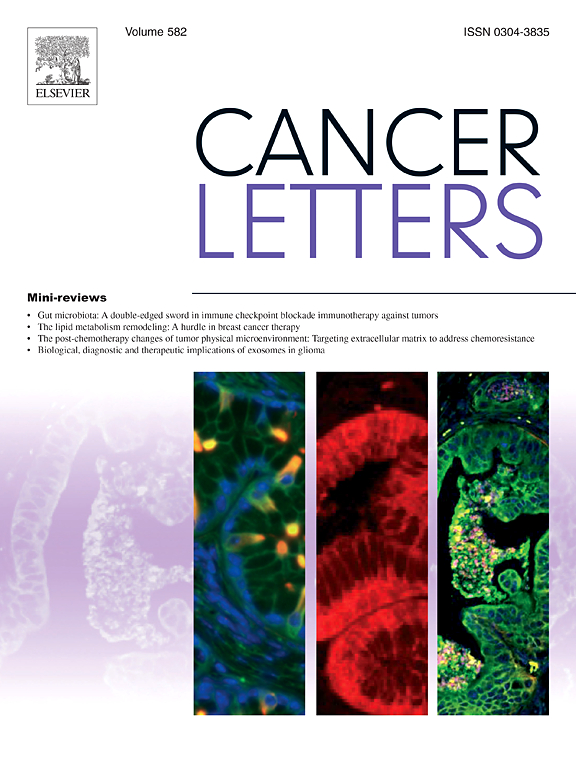应用cfDNA片段化的先进集合桩模型早期检测食管癌和胃癌
IF 9.1
1区 医学
Q1 ONCOLOGY
引用次数: 0
摘要
食管癌和胃癌是侵袭性恶性肿瘤,由于诊断较晚,预后较差。我们的研究招募了275名健康参与者,201名胃癌患者,74名食管癌患者和103名癌前病变患者。参与者被分配到培训组和验证组。在对所有血浆样本进行低深度全基因组测序后,构建了一个堆叠的集成模型,整合了三个cfDNA片段组学特征:拷贝数变异、片段大小谱和片段甲基化。采用5次交叉验证对多维模型进行训练,并通过验证对其性能进行评价。检测灵敏度和特异性在95%特异性训练集验证。叠置集成模型在验证数据集中的AUC为0.967。在95%的特异性阈值下,该模型达到了79.2%的高灵敏度,强调了其在区分癌症和健康个体方面的临床应用。值得注意的是,在训练和验证队列中,它对I期病例的敏感性分别为77.4%和68.3%。该模型还能有效识别癌前病变,对胃癌和食管癌前病变的AUC为0.828,敏感性为53.8%和71.4%,同时在确定良性病变方面保持清晰的评分差异。总的来说,我们的堆叠模型在识别食管癌和胃癌方面具有很高的灵敏度,为内窥镜检查提供了一种强大的、非侵入性的替代方法。这种方法支持及时干预,并通过早期和更有针对性的治疗来改善患者的预后。本文章由计算机程序翻译,如有差异,请以英文原文为准。
Advanced ensemble staking model employing cfDNA fragmentation for early detection of esophageal and gastric cancer
Esophageal and gastric cancers are aggressive malignancies with poor prognoses due to late-stage diagnosis. Our study recruited 275 healthy participants, 201 gastric cancer patients, 74 esophageal patients and 103 patients with precancerous conditions. The participants were assigned into training and validation cohorts. After processing a low-depth whole genome sequencing for all plasma samples, a stacked ensembled model was constructed, integrating three cfDNA fragmentomic features: Copy Number Variation, Fragment Size Profile, and Fragment Based Methylation. The multi-dimensional model was trained with 5-fold cross-validation, and its performance was evaluated through validation. The detection sensitivity and specificity were validated at 95 % specificity of training set. The stacked ensemble model achieved an AUC of 0.967 in the validation dataset. At a 95 % specificity threshold, the model attained a high sensitivity of 79.2 %, underscoring its clinical utility in distinguishing cancer from healthy individuals. Notably, it achieved sensitivity of 77.4 % and 68.3 % for stage I cases in training and validation cohorts, respectively. The model also identified precancerous conditions effectively, with an AUC of 0.828 and sensitivity of 53.8 % and 71.4 % for gastric and esophageal precancer lesions, while maintaining clear score distinctions in specifying benign diseases. Overall, our stacked model achieved high sensitivity in identifying esophageal and gastric cancer, offering a strong, non-invasive alternative to endoscopy. This approach supports timely intervention and improved patient outcomes by enabling earlier and more targeted treatment.
求助全文
通过发布文献求助,成功后即可免费获取论文全文。
去求助
来源期刊

Cancer letters
医学-肿瘤学
CiteScore
17.70
自引率
2.10%
发文量
427
审稿时长
15 days
期刊介绍:
Cancer Letters is a reputable international journal that serves as a platform for significant and original contributions in cancer research. The journal welcomes both full-length articles and Mini Reviews in the wide-ranging field of basic and translational oncology. Furthermore, it frequently presents Special Issues that shed light on current and topical areas in cancer research.
Cancer Letters is highly interested in various fundamental aspects that can cater to a diverse readership. These areas include the molecular genetics and cell biology of cancer, radiation biology, molecular pathology, hormones and cancer, viral oncology, metastasis, and chemoprevention. The journal actively focuses on experimental therapeutics, particularly the advancement of targeted therapies for personalized cancer medicine, such as metronomic chemotherapy.
By publishing groundbreaking research and promoting advancements in cancer treatments, Cancer Letters aims to actively contribute to the fight against cancer and the improvement of patient outcomes.
 求助内容:
求助内容: 应助结果提醒方式:
应助结果提醒方式:


